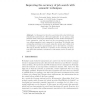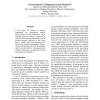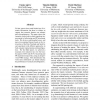COLING
2008
14 years 29 days ago
2008
We propose an approach to natural language inference based on a model of natural logic, which identifies valid inferences by their lexical and syntactic features, without full sem...
CSSW
2007
14 years 29 days ago
2007
Abstract: Semantic wikis have been introduced for collaborative authoring of ontologies as well as for annotating wiki content with semantic meta data. In this paper, we introduce ...
BIS
2007
14 years 29 days ago
2007
In this paper we introduce a prototype job portal which uses semantically annotated job offers and applicants. In our opinion, using Semantic Web technologies substantially increa...
BIS
2007
14 years 29 days ago
2007
Abstract. Most approaches to B2B interoperability are based on language syntax standardisation, usually by XML Schemas. However, due to XML expressivity limitations, they are diffi...
BIS
2007
14 years 29 days ago
2007
The recent evolution of the Web, now designated by the term Web 2.0, has seen the appearance of a huge number of resources created and annotated by users. However the annotations ...
AVI
2010
14 years 29 days ago
2010
Urban environments require cognitive abilities focused on both spatial overview and detailed understanding of uses and places. These abilities are distinct but overlap and reinfor...
ACL
2008
14 years 29 days ago
2008
In this paper we propose a domainindependent text segmentation method, which consists of three components. Latent Dirichlet allocation (LDA) is employed to compute words semantic ...
ACL
2008
14 years 29 days ago
2008
We present a novel fine-grained semantic representation of text and an approach to constructing it. This representation is largely extractable by today's technologies and fac...
ACL
2008
14 years 29 days ago
2008
To date, parsers have made limited use of semantic information, but there is evidence to suggest that semantic features can enhance parse disambiguation. This paper shows that sem...
ESWS
2008
Springer
14 years 1 months ago
2008
Springer
Many tasks on the semantic web require the user to choose concepts from a limited vocabulary e.g. for describing an indexed resource or for use in semantic search. Semantic autocom...



